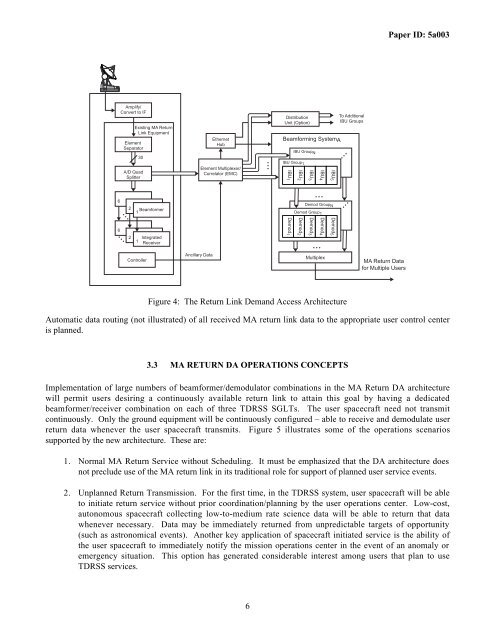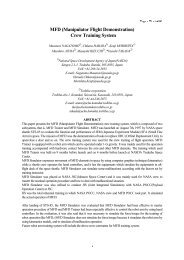TDRSS DEMAND ACCESS SERVICE: APPLICATION OF ...
TDRSS DEMAND ACCESS SERVICE: APPLICATION OF ...
TDRSS DEMAND ACCESS SERVICE: APPLICATION OF ...
Create successful ePaper yourself
Turn your PDF publications into a flip-book with our unique Google optimized e-Paper software.
6<br />
6<br />
Amplify/<br />
Convert to IF<br />
Element<br />
Separator<br />
A/D Quad<br />
Splitter<br />
Existing MA Return<br />
Link Equipment<br />
30<br />
2 Beamformer<br />
1<br />
2 1 Integrated<br />
Receiver<br />
Controller<br />
Ancillary Data<br />
Ethernet<br />
Hub<br />
Element Multiplexer/<br />
Correlator (EMC)<br />
6<br />
Distribution<br />
Unit (Option)<br />
Beamforming SystemA<br />
IBU Group N<br />
IBU Group 1<br />
Paper ID: 5a003<br />
Automatic data routing (not illustrated) of all received MA return link data to the appropriate user control center<br />
is planned.<br />
3.3 MA RETURN DA OPERATIONS CONCEPTS<br />
Implementation of large numbers of beamformer/demodulator combinations in the MA Return DA architecture<br />
will permit users desiring a continuously available return link to attain this goal by having a dedicated<br />
beamformer/receiver combination on each of three <strong>TDRSS</strong> SGLTs. The user spacecraft need not transmit<br />
continuously. Only the ground equipment will be continuously configured – able to receive and demodulate user<br />
return data whenever the user spacecraft transmits. Figure 5 illustrates some of the operations scenarios<br />
supported by the new architecture. These are:<br />
1. Normal MA Return Service without Scheduling. It must be emphasized that the DA architecture does<br />
not preclude use of the MA return link in its traditional role for support of planned user service events.<br />
2. Unplanned Return Transmission. For the first time, in the <strong>TDRSS</strong> system, user spacecraft will be able<br />
to initiate return service without prior coordination/planning by the user operations center. Low-cost,<br />
autonomous spacecraft collecting low-to-medium rate science data will be able to return that data<br />
whenever necessary. Data may be immediately returned from unpredictable targets of opportunity<br />
(such as astronomical events). Another key application of spacecraft initiated service is the ability of<br />
the user spacecraft to immediately notify the mission operations center in the event of an anomaly or<br />
emergency situation. This option has generated considerable interest among users that plan to use<br />
<strong>TDRSS</strong> services.<br />
IBU 1<br />
Demod 1<br />
IBU 2<br />
Demod 2<br />
IBU 3<br />
Demod 3<br />
IBU 4<br />
Demod Group 1<br />
Demod 4<br />
IBU 5<br />
Demod Group N<br />
Multiplex<br />
Figure 4: The Return Link Demand Access Architecture<br />
Demod 5<br />
To Additional<br />
IBU Groups<br />
MA Return Data<br />
for Multiple Users



